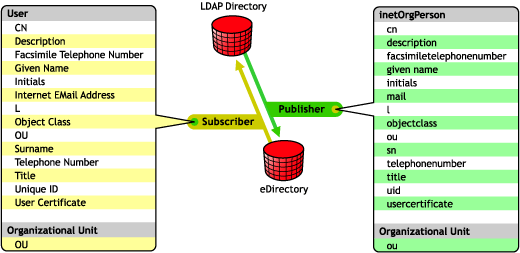Default Driver Configuration
DirXML fundamentals are explained in the Novell Nsure Identity Manager 2 Administration Guide. This section discusses implementations, additions, or exceptions specific to this driver.
Data Flow
Publisher and Subscriber Channels
The driver supports Publisher and Subscriber channels:
- The Publisher reads information from the LDAP directory change log and submits that information to eDirectory via the DirXML engine.
By default, the Publisher checks the log every 20 seconds, processing up to a 1000 entries at a time, starting with the first unprocessed entry.
- The Subscriber watches for additions and modifications to eDirectory objects and issues LDAP commands that will make changes to the LDAP directory.
Filters
DirXML uses filters to control which objects and attributes are shared. The default filter configurations for the LDAP driver allow objects and attributes to be shared, as illustrated in the following figure:
図 1LDAP Driver Filters

Policies
Policies are used to control data synchronization between the driver and eDirectory. The LDAP driver comes with two preconfiguration options to set up policies.
- The Flat option implements a flat structure for users in both directories.
With this configuration, when user objects are created in one directory, they are placed in the root of the container you specified during driver setup for the other directory (the container name does not have to be the same in both eDirectory and the LDAP directory). When existing objects are updated, their context is preserved.
- The Mirror option matches the hierarchical structure in the directories.
With this configuration, when new user objects are created in one directory, they are placed in the matching hierarchical level of the mirror container in the other directory. When existing objects are updated, their context is preserved.
Except for the Placement policy and the fact that the Flat configuration doesn't synchronize Organizational Unit objects, the policies set up for these options is identical.
Default policies are detailed in the following table. These policies and the individual rules they contain can be customized through Novell iManager as explained in Customizing the LDAP Driver.